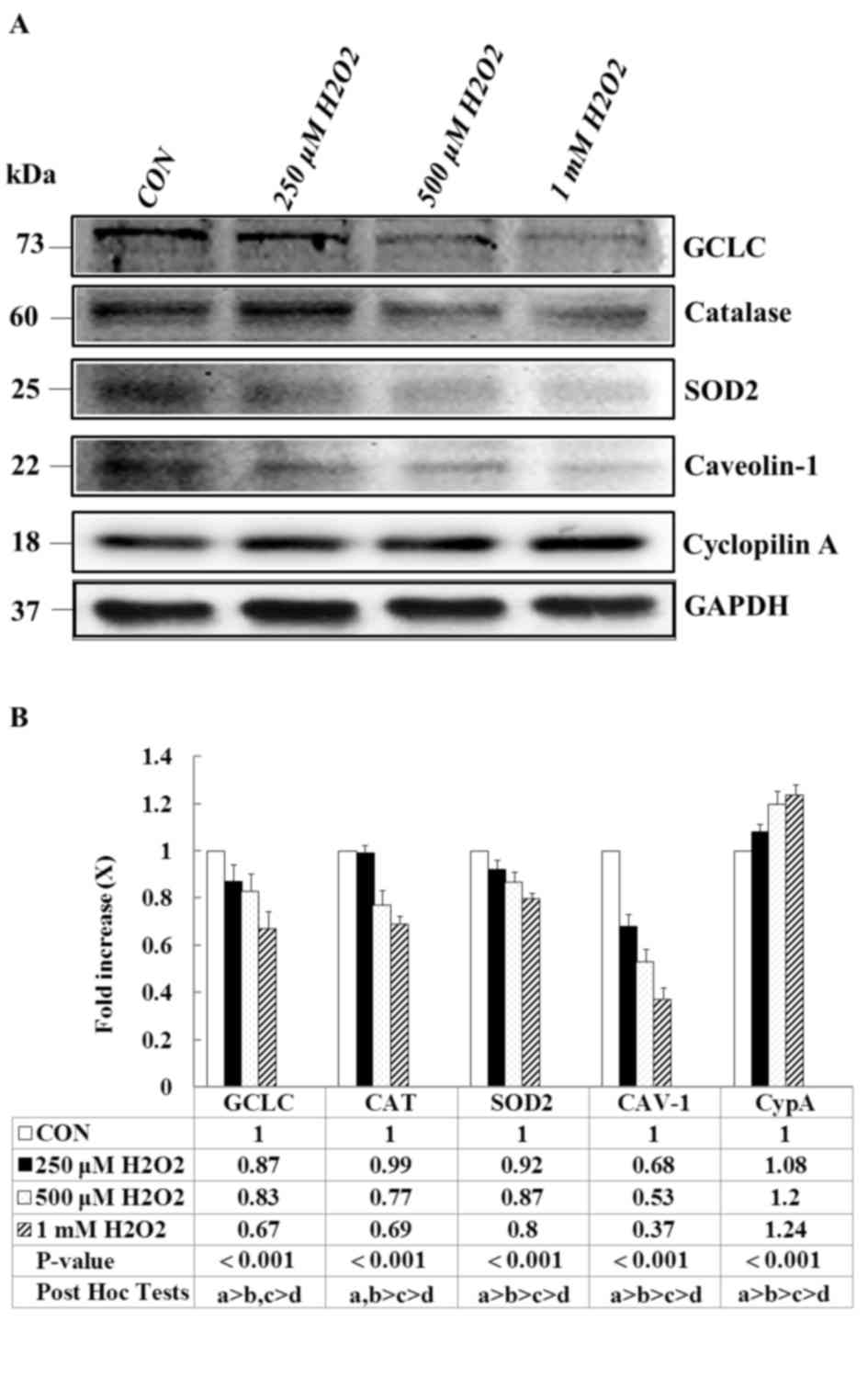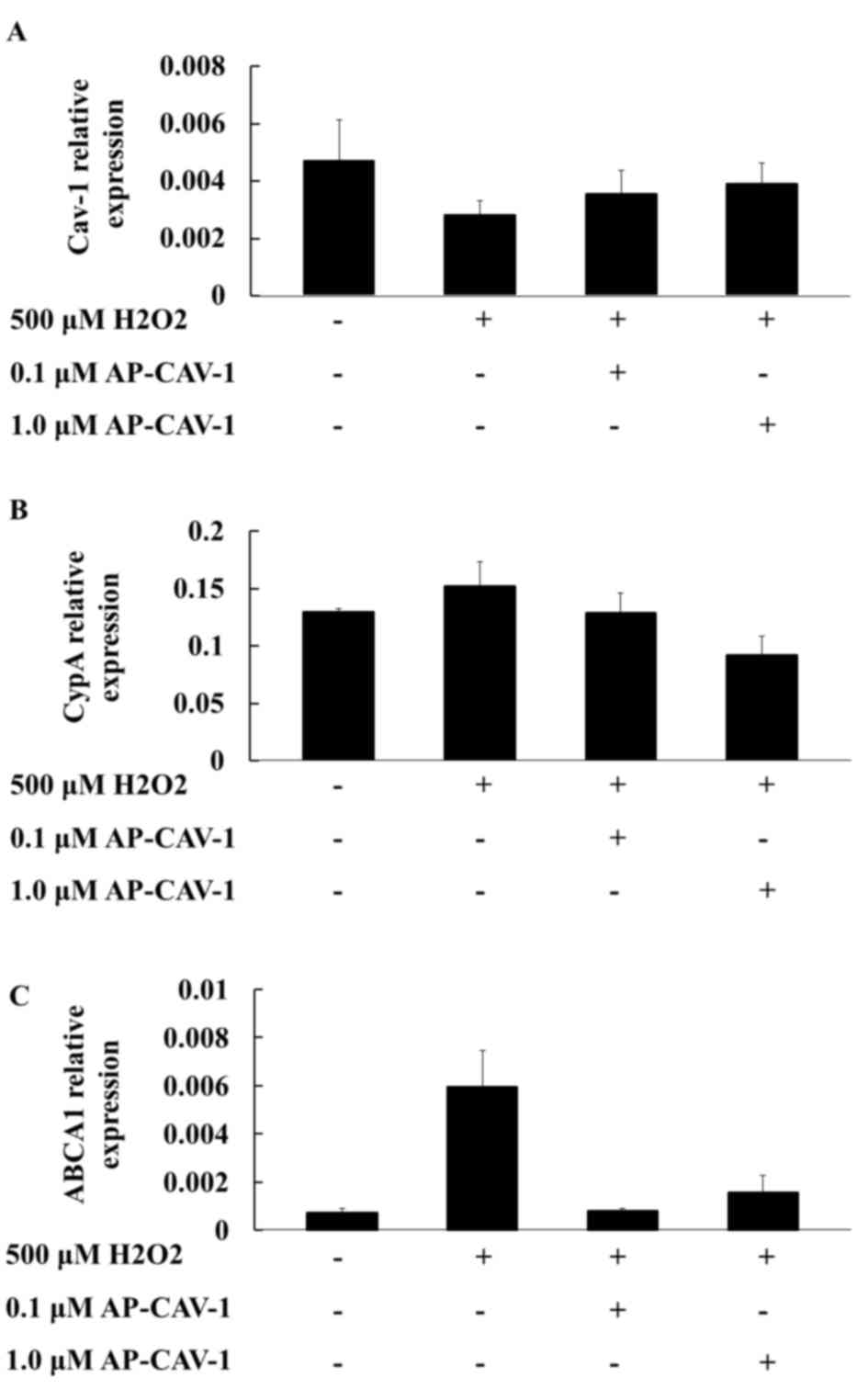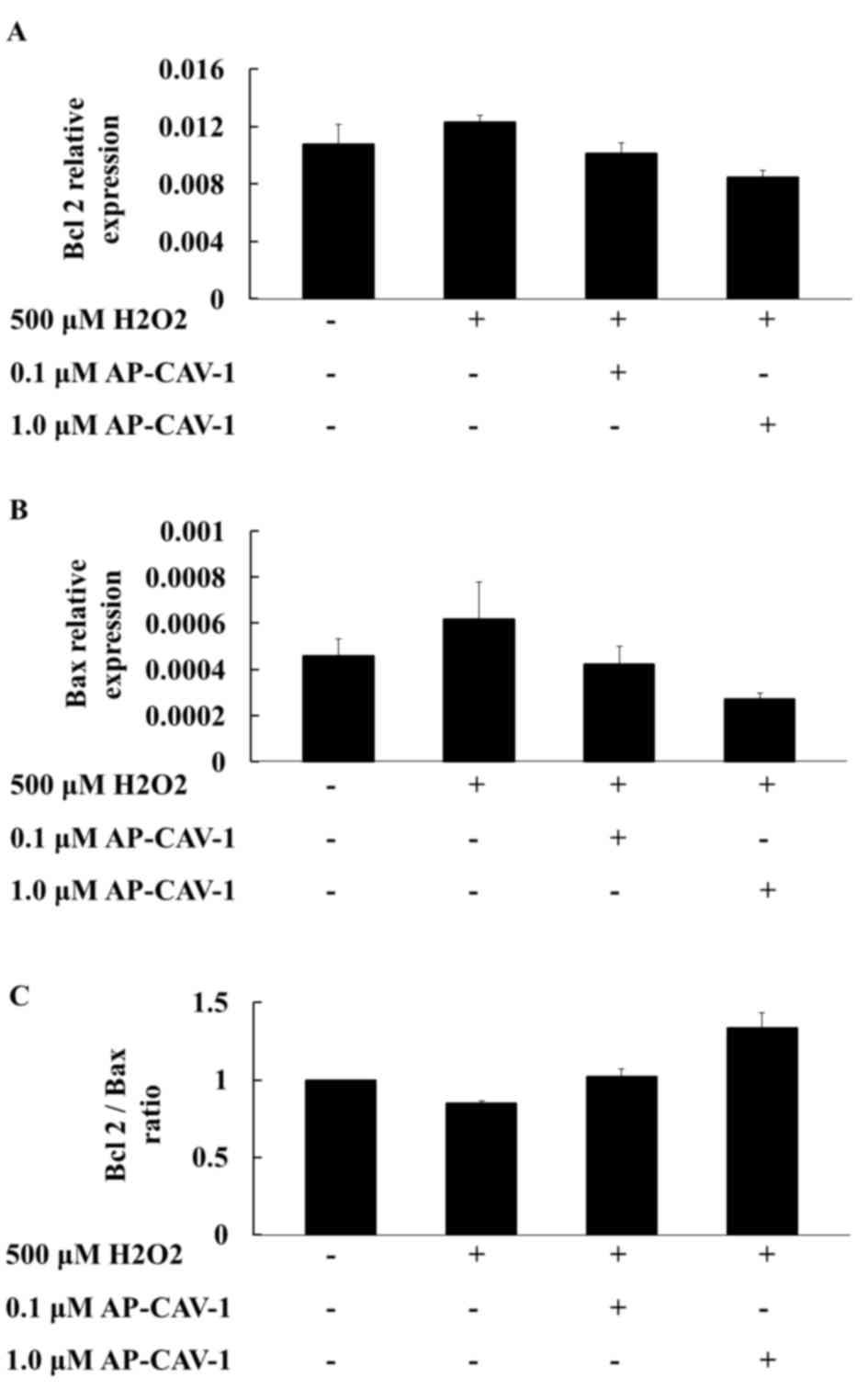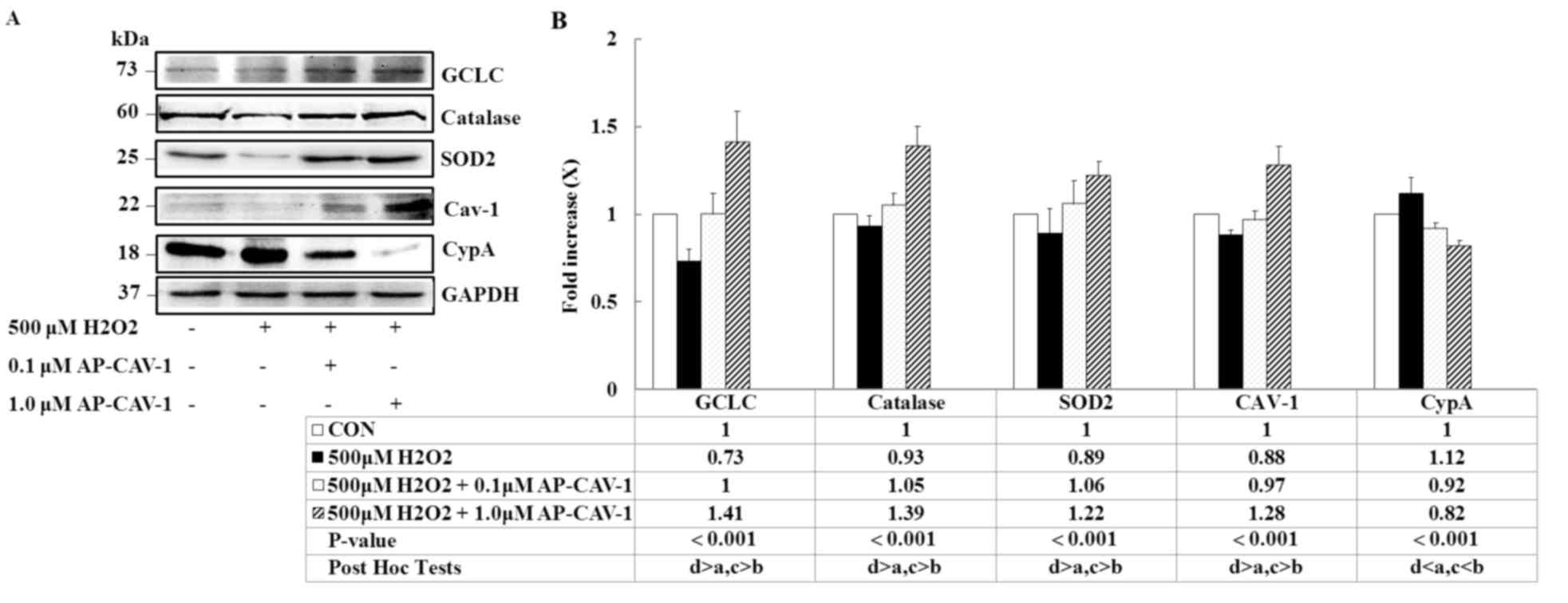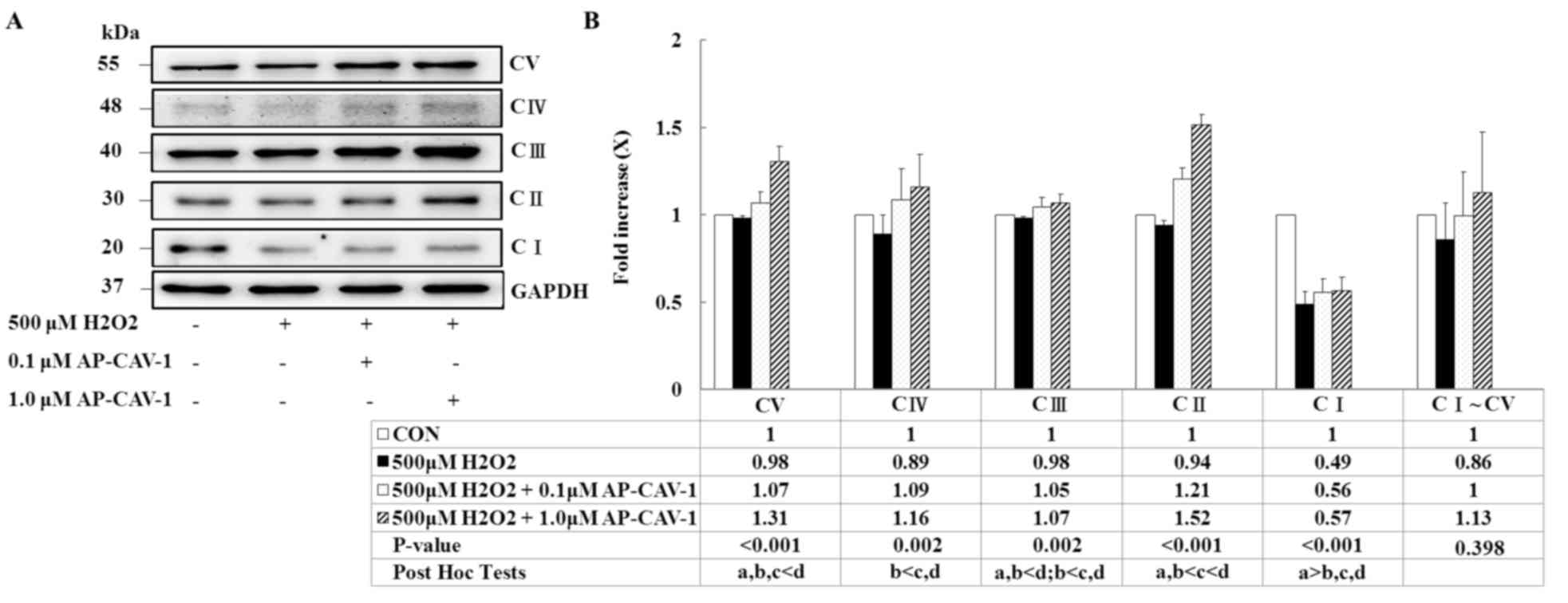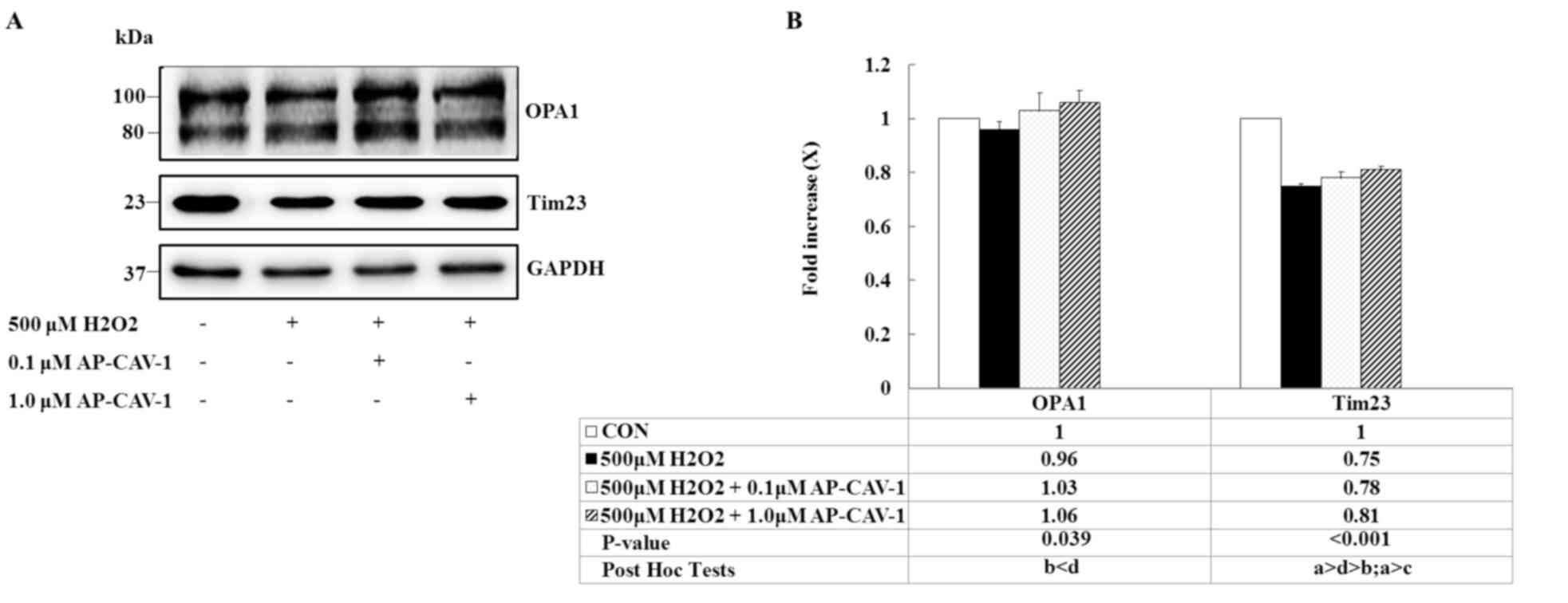H2O2 induces caveolin‑1 degradation and impaired mitochondrial function in E11 podocytes
- Authors:
- Published online on: September 18, 2017 https://doi.org/10.3892/mmr.2017.7497
- Pages: 7841-7847
Abstract
Introduction
Glomerular podocytes are highly specialized cells with a complex cellular organization that assist the kidneys in blood filtration. Podocytes also serve a crucial role in the synthesis of glomerular basement membrane components, the formation of the slit membrane and interactions that ensure endothelial cell viability (1,2). Several studies have revealed that podocyte injury results in the effacement of foot processes and proteinuria, and ultimately leads to consequence of acquired glomerular diseases (1,3). In 2009, Ronconi et al (4) indicated that the podocyte damage that occurs in the pathogenesis of glomerulosclerosis could potentially be repaired through stem cell regeneration in the kidney. Furthermore, the effacement of podocytes and the decrease in their density appear to be central to the pathogenesis of diabetic nephropathy (DN). Injuries sustained because of increased oxidative stress constitute the most crucial mechanism (5,6). Recently, Mallipattu and He (7) reported that podocytes are terminally differentiated and have a minimal capacity to self-replicate; therefore, they are extremely sensitive to cellular injury. When podocyte injury occurs, it directly causes the onset and progression of glomerular diseases such as focal segmental glomerular sclerosis, minimal change disease, DN and human immunodeficiency virus-associated nephropathy. Therefore, understanding the biological mechanisms involved in podocyte injury may provide novel therapeutic targets for preventing or mitigating progression to end-stage renal failure.
Caveolin (CAV)-1 is an essential protein component of caveolae, which are omega-shaped plasma membrane invaginations rich in sphingolipids and cholesterol. In addition to maintaining cholesterol homeostasis, CAV-1 is involved in regulating vesicular transport, signal transduction and tumor progression (8,9). Cellular organelles such as mitochondria, nuclei and endoplasmic reticuli are rich in CAVs, and CAV-1 is highly expressed in vascular endothelial cells, adipocytes, smooth muscle cells and fibroblasts (10). In CAV-1-deficient fibroblasts, >40 upregulated protein biomarkers have been identified. Most of these biomarkers are associated with myofibroblast differentiation or oxidative stress hypoxia (11). The absence of CAV-1 causes cholesterol-dependent mitochondrial dysfunction and apoptotic susceptibility (12). By contrast, previous studies have demonstrated that CAV-1 is highly expressed in podocytes and interacts with the podocyte slit diaphragm protein nephrin and CD2AP (13,14). Previous studies demonstrated that angiotensin II induces nephrin dephosphorylation and podocyte injury through a CAV-1-dependent mechanism; therefore, CAV-1 is potentially a novel therapeutic target in nephrotic syndrome and podocyte injury (15–17). Hence, demonstrating the cell-specific role of CAV-1 in the pathogenesis of renal-associated disease may be crucial.
The present study used antennapedia-conjugated CAV-1 peptide, which is a Drosophila transcription factor facilitating CAV-1 translocation across the cell membrane (18,19), in a H2O2-induced podocyte dysfunction model. To evaluate CAV-1-induced changes in the H2O2-dependent mechanism in injured podocyte cells, the present study examined the mRNA expression levels of CAV-1, cyclophilin A (CypA) and ATP-binding cassette transporter A1 (ABCA1), as well as the mitochondrial function, oxidative and antioxidative homeostasis, and apoptosis of E11 podocytes.
Materials and methods
Materials
Antenapedia-CAV-1 (AP-CAV-1) peptide [RQPKIWEFPNRRKPWKK-DGIWKA SFTTFVTKYWFYR-(OH)] was obtained from AllBio Science, Inc., (Taiwan). Hydrogen peroxide solution (H2O2) was purchased from the Sigma-Aldrich; Merck KGaA (Darmstadt, Germany). Antibodies against monoclonal anti-CAV-1 (cat no. 1249-1; 1:1,000; Epitomics; Abcam, Cambridge, MA, USA), monoclonal anti-CyP A (cat no. GTX113520; 1:1,000; GeneTex, Inc., Irvine, CA, USA), polyclonal anti-superoxide dismutase 2 (SOD2; cat no. NB100-1992; 1:1,000; Novus Biologicals, LLC, Littleton, CO, USA), polyclonal anti-catalase (cat no. ab16731; 1:1,000; Abcam), polyclonal anti-glutamate-cysteine ligase catalytic subunit (GCLC; cat no. GTX113197; 1:800; GeneTex, Inc.), mouse anti-optic atrophy 1 (OPA1; cat no. 612607; 1:1,000; BD Biosciences, San Jose, CA, USA), mouse anti-translocase of the inner membrane 23 (Tim23; cat no. 611222; 1:1,000; BD Biosciences), MitoProfile Total oxidative phosphorylation (OXPHOS) rodent antibody cocktail (cat no. ab110413; 1:800; MitoSciences; Abcam), and mouse anti-glyceraldehyde-3-phosphate dehydrogenase (GAPDH; cat no. ab8245; 1:1,000; Abcam).
Cell culture
The E11 murine kidney podocyte cell line was obtained from CLS Cell Lines Service GmbH (Germany) and was maintained in RPMI 1640 medium (Amimed, BioConcept Ltd., Switzerland) supplemented with 10% FBS (Gibco; Thermo Fisher Scientific, Inc., Waltham, MA, USA), 100 U/ml penicillin and 100 g/ml streptomycin (TOKU-E, Bellingham, WA, USA), 20 U/ml human recombinant interferon gamma (IFN-γ; ProSpec-Tany TechnoGene Ltd., East Brunswick, NJ, USA) at 33°C in a humidified 5% CO2 incubator.
Western blot analysis and quantification
Cells were pretreated with the indicated concentration of H2O2 for 1 h, followed by treatment with an indicated concentration of AP-CAV-1 peptide for an addition 48 h. Cells were washed with ice-cold PBS and lysed in radioimmunoprecipitation assay buffer, and centrifuged at 20,000 × g for 20 min at 4°C. The protein concentration was detected using a Bicinchoninic Acid protein assay kit (Thermo Fisher Scientific, Inc.). Proteins (20 µg) were separated by 12% SDS-PAGE and then transferred to polyvinylidene difluoride membranes. The membrane was probed with the indicated primary antibodies at 4°C overnight, and then with horseradish peroxidase-conjugated goat anti-mouse (cat no. 115-035-003; 1:50,000; Jackson ImmunoResearch Laboratories, Inc., West Grove, PA, USA) and goat anti-rabbit (cat no. 31460; 1:100,000; Thermo Fisher Scientific, Inc.) secondary antibodies at room temperature for 1 h, and signals were obtained using an enhanced chemiluminescence kit (EMD Millipore, Billerica, MA, USA). Blots were semi-quantified by densitometry using Fusion-Capt Advance FX7 software versoin 16.08a on a Fusion FX7 imaging system (Labtech International, Inc., Vilber Lourmat, France).
RNA isolation and reverse transcription-quantitative polymerase chain reaction (RT-qPCR)
Total RNA was prepared using an AllPure Total RNA Isolation kit (AllBio Science Inc., Taichung, Taiwan) according to the manufacturer's protocol. Reverse transcription and qPCR were performed using AllScript First-Strand cDNA Synthesis SuperMix and AllScript Green qPCR SuperMix UDG (AllBio Science, Inc.) according to the manufacturer's protocol. qPCR analysis was used to determine the relative levels of CAV-1, CypA, ATP-binding cassette transporter A1 (ABCA1), B-cell lymphoma 2 (Bcl2), and BCL2-associated X protein (Bax) mRNA. β-actin was performed in the same reaction on all samples tested as an internal control for variations in RNA amounts. Relative gene expression was quantified according to the comparative Cq method and normalized to β-actin mRNA levels (20). The gene-specific primers are listed in Table I. The thermocycling conditions for qPCR included an initial phase of 3 min at 50°C, followed by 10 sec at 94°C and 40 cycles of 5 sec at 94°C, 15 sec at 60°C and 15 sec at 72°C. Each sample was assayed in duplicate, and fluorescence spectra were continuously monitored using the LightCycler 480 Detection system (Roche, Basel, Switzerland).
Statistical analysis
Statistical analyses were performed using one-way analysis of variance followed by Bonferroni's post hoc test in SPSS software version 22.0 (IBM Corp., Armonk, NY, USA). Data are presented as mean ± standard deviation. P<0.05 was considered to indicate a statistically significant difference.
Results
Effects of H2O2 on expression levels of antioxidant-associated proteins, CAV-1 and CypA in E11 podocytes
To determine the effects of H2O2 on the antioxidant-associated proteins of podocytes, E11 cells were treated with various concentrations of H2O2 for 1 h. The expression of antioxidant-associated proteins was measured through western blot analysis. A significant and dose-dependent decrease was observed in the expression of the antioxidant enzymes GCLC, catalase and SOD2 in the H2O2-treated groups compared with the vehicle control (Fig. 1A). Similarly, the H2O2 treatment markedly reduced the expression of CAV-1; whereas the expression of CypA, which is an inflammatory marker, was significantly upregulated. The quantification of the results is presented in Fig. 1B (P<0.001). These results suggested that H2O2 significantly affects the antioxidant capacities of podocytes, thus promoting intercellular inflammation and altering mitochondrial antioxidant capacity.
Effects of CAV-1 on the mRNA expression levels of the CypA and ABCA1 genes
The present study examined whether AP-CAV-1 treatment exerted additional effects on the expression levels of CAV-1 and CypA in H2O2-treated E11 cells. RT-qPCR assay results revealed that the mRNA expression levels of CAV-1 and CypA in the AP-CAV-1-treated group were significantly elevated and diminished, respectively, compared with those of the H2O2-treated group (Figs. 2A and B, respectively). The quantification of the results is presented in Table II (CAV-1, P=0.018; CypA, P<0.001). Furthermore, the ABCA1 mRNA levels in the E11 podocytes were significantly higher in the H2O2-treated group compared with the control group. In the AP-CAV-1-treated E11 cells, CAV-1 provided protection from H2O2-associated damage and the change in the ABCA1 mRNA expression level was significantly reduced (Fig. 2C). However, no significant difference was observed for ABCA1 mRNA levels between AP-CAV-1-treated groups. Overall, these results indicated that CAV-1 diminished H2O2-induced E11 podocytes injuries and prevented ABCA1 compensatory action from becoming excessively active in the H2O2-treated E11 cells.
Table II.mRNA expression levels of CAV-1, CypA and ABCA1 in the control and AP-CAV-1-H2O2-treated E11 cells. |
Effects of CAV-1 on apoptosis-associated gene mRNA expression levels
To investigate whether CAV-1 activity affects cell survival, the present study examined the expression of apoptosis-associated gene mRNA expression levels in E11 cells by RT-qPCR. A higher compensatory mRNA level of Bcl2 was observed in the H2O2-treated E11 cells. CAV-1 treatment significantly suppressed Bcl2 mRNA expression in a dose-dependent manner (Fig. 3A). The Bax mRNA expression levels were more markedly diminished in the CAV-1-treated groups than in the H2O2-treated group (Fig. 3B). The quantification of the results is presented in Table III. The Bcl2/Bax ratios were also higher in the CAV-1 groups compared with the H2O2-treated group. CAV-1 provided podocytes with resistance to apoptotic stimuli (Fig. 3C). These results suggested that CAV-1 may prevent apoptotic cell death in E11 podocytes.
Table III.mRNA expression levels of Bcl2 and Bax in the control and AP-CAV-1-H2O2-treated E11 cells. |
Effects of CAV-1 on H2O2-induced changes
To determine whether AP-CAV-1 treatment was associated with a local decrease in oxidative stress, the present study measured the expression levels of the antioxidant enzymes GCLC, catalase and SOD2 in E11 podocytes. A significant elevation of three markers was observed in the AP-CAV-1-treated E11 cells (Fig. 4; P<0.001). The expressions of the pro-inflammatory markers CypA and CAV-1 were significantly lower and higher, respectively, in the AP-CAV-1-treated groups compared with the H2O2-treated groups (Fig. 4; P<0.001). Thus, AP-CAV-1 may have increased antioxidant enzyme activity and attenuated local oxidative damage in the CAV-1-treated E11 cells.
CAV-1 preserves mitochondrial respiratory function by upregulating OXPHOS expression
The present study used western blot analysis to examine mitochondrial OXPHOS complexes because they directly affect mitochondrial function and antioxidative capacity. The expression levels of the ATP synthase α-subunit (complex V), cytochrome c oxidase subunit 1 (MTCO1; complex IV), core 2 protein (complex III), Succinate dehydrogenase [ubiquinone] iron-sulfur subunit, mitochondrial (SDHB; complex II) and NADH dehydrogenase [ubiquinone] 1 β subcomplex subunit 8 (NDUFB8; complex I) were significantly enhanced in a dose-dependent manner in the AP-CAV-1-treated groups compared with the H2O2-treated-group (P<0.001 vs. P=0.002). AP-CAV-1 treatment resulted in a significantly increased expression of electron transport chain complex I–V protein, suggesting that CAV-1 treatment preserves mitochondrial respiratory function in H2O2-treated E11 podocytes (Fig. 5).
CAV-1 prevents OPA1 and Tim23 degradation
The present study determined whether OPA1 and Tim23 expression levels that are upregulated by CAV-1 treatment prevent H2O2-induced apoptosis in E11 podocytes. OPA1 is a protein required for inner mitochondrial membrane fusion. H2O2 exposure decreased the intensity levels of both bands, whereas OPA1 levels markedly increased after CAV-1 treatment. Similarly, CAV-1 prevented a substantial decrease in the expression of the inner-membrane protein Tim23 from being induced by the H2O2 insult (Fig. 6, P=0.039 and P<0.001, respectively). These data suggested that CAV-1 prevents the mitochondrial fusion mechanism from undergoing OPA1 deregulation, and preserves the integrity of Tim23 content, mediating the translocation of proteins into the mitochondrial matrix in response to in vitro H2O2-induced toxicity.
Discussion
The present study demonstrated that H2O2 induces reactive oxygen species (ROS) production, oxidative stress, inflammation, cell apoptosis and mitochondrial dysfunction in podocytes, and that treatment with CAV-1 prevents H2O2-induced ROS production, oxidative stress, inflammation, cell apoptosis and mitochondrial dysfunction, indicating that CAV-1 functions as a positive regulator in podocyte injury.
ROS overexpression has been observed in glomerular endothelial and epithelial cells and has been demonstrated to disrupt normal glomerular permselectivity, thus leading to proteinuria (21,22). The inhibition of ROS generation through the use of NADPH oxidase inhibitors, renin-angiotensin-aldosterone system inhibitors, statins, antidiabetic drugs and antioxidant vitamins may ameliorate the renal damage caused by diabetic nephropathy (5,6). CAV-1 has been associated with oxidative regulating pathways. Chen et al (23) demonstrated that CAV-1 is a negative regulator of NADPH oxidase-induced ROS in endothelial cells, and Sun et al (24) demonstrated that CAV-1 significantly reduces ROS production and apoptosis in podocytes. Similarly, the results of the present study revealed that increased CAV-1 expression not only promotes GCLC, SOD2 and catalase expression to increase antioxidant defensive capacity, but also downregulates the Bcl2/Bax expression ratio, thus preventing podocyte cell death. However, Volonte et al (25) revealed that the CAV-1 interaction with nuclear factor erythroid 2-related factor 2-GCLC proteins negatively regulated antioxidant defenses in fibroblasts. Hence, the differences observed in the roles of CAV-1 in oxidative regulating pathways are cell-type specific.
Crucially, the CAV-1 expression level was markedly affected by the addition of H2O2 to the culture medium; the CAV-1 level decreased by nearly 50–70%. Similarly, previous studies demonstrated that the expression of CAV-1 is significantly decreased after H2O2 treatment in cardiomyocytes and skeletal muscle cells (26,27). Several studies have suggested that the rapid degradation of CAV-1 protein could be caused by the ubiquitin-proteasome pathway, particularly after oxidative injury (28,29). The present study revealed that H2O2 had a reversible effect on CAV-1 expression when podocyte cells were incubated with an AP-CAV-1 peptide, and that CAV-1 protein degradation could then trigger cellular mitochondrial function and antioxidant defense.
In conclusion, the results of the present study demonstrated that CAV-1 provides protection against the H2O2-induced oxidative stress response, as demonstrated by an increase in the activity of the antioxidant enzymes GCLC, SOD2 and catalase. CAV-1 also attenuated the expression of the proinflammatory marker CypA, altered Bcl2/Bax mRNA expression levels, suppressed apoptotic cell death and preserved mitochondrial functions such as upregulated OXPHOS, OPA-1 and Tim23 protein expression levels. Therefore, targeting enhanced CAV-1 expression levels in podocyte injury may have potential as a therapeutic strategy for the treatment of glomerular injury.
Acknowledgements
The present study was supported by the Changhua Christian Hospital (grant. no. 105-CCH-IRP-133).
References
|
Pavenstädt H, Kriz W and Kretzler M: Cell biology of the glomerular podocyte. Physiol Rev. 83:253–307. 2003. View Article : Google Scholar : PubMed/NCBI | |
|
Nagata M: Podocyte injury and its consequences. Kidney Int. 89:1221–1230. 2016. View Article : Google Scholar : PubMed/NCBI | |
|
Asanuma K and Mundel P: The role of podocytes in glomerular pathobiology. Clin Exp Nephrol. 7:255–259. 2003. View Article : Google Scholar : PubMed/NCBI | |
|
Ronconi E, Mazzinghi B, Sagrinati C, Angelotti ML, Ballerini L, Parente E, Romagnani P, Lazzeri E and Lasagni L: The role of podocyte damage in the pathogenesis of glomerulosclerosis and possible repair mechanisms. G Ital Nefrol. 26:660–669. 2009.PubMed/NCBI | |
|
Kashihara N, Haruna Y, Kondeti VK and Kanwar YS: Oxidative stress in diabetic nephropathy. Curr Med Chem. 17:4256–4269. 2010. View Article : Google Scholar : PubMed/NCBI | |
|
Bhatti AB and Usman M: Drug Targets for Oxidative Podocyte Injury in Diabetic Nephropathy. Cureus. 7:e3932015.PubMed/NCBI | |
|
Mallipattu SK and He JC: The podocyte as a direct target for treatment of glomerular disease? Am J Physiol Renal Physiol. 311:F46–F51. 2016. View Article : Google Scholar : PubMed/NCBI | |
|
Panneerselvam M, Patel HH and Roth DM: Caveolins and Heart DiseasesCaveolins and Caveolae: Roles in Signaling and Disease Mechanisms. Jasmin JF, Frank PG and Lisanti MP: Springer US; New York, NY: pp. 145–156. 2012, View Article : Google Scholar | |
|
Frank PG, Pavlides S, Cheung MW, Daumer K and Lisanti MP: Role of caveolin-1 in the regulation of lipoprotein metabolism. Am J Physiol Cell Physio. 295:C242–C248. 2008. View Article : Google Scholar | |
|
Mercier I, Jasmin JF, Pavlides S, Minetti C, Flomenberg N, Pestell RG, Frank PG, Sotgia F and Lisanti MP: Clinical and translational implications of the caveolin gene family: Lessons from mouse models and human genetic disorders. Lab Invest. 89:614–623. 2009. View Article : Google Scholar : PubMed/NCBI | |
|
Trimmer C, Sotgia F, Whitaker-Menezes D, Balliet RM, Eaton G, Martinez-Outschoorn UE, Pavlides S, Howell A, Iozzo RV, Pestell RG, et al: Caveolin-1 and mitochondrial SOD2 (MnSOD) function as tumor suppressors in the stromal microenvironment: A new genetically tractable model for human cancer associated fibroblasts. Cancer Biol Ther. 11:383–394. 2011. View Article : Google Scholar : PubMed/NCBI | |
|
Bosch M, Marí M, Herms A, Fernández A, Fajardo A, Kassan A, Giralt A, Colell A, Balgoma D, Barbero E, et al: Caveolin-1 deficiency causes cholesterol-dependent mitochondrial dysfunction and apoptotic susceptibility. Curr Biol. 21:681–686. 2011. View Article : Google Scholar : PubMed/NCBI | |
|
Sörensson J, Fierlbeck W, Heider T, Schwarz K, Park DS, Mundel P, Lisanti M and Ballermann BJ: Glomerular endothelial fenestrae in vivo are not formed from caveolae. J Am Soc Nephrol. 13:2639–2647. 2002. View Article : Google Scholar : PubMed/NCBI | |
|
Ostalska-Nowicka D, Nowicki M, Zachwieja J, Kasper M and Witt M: The significance of caveolin-1 expression in parietal epithelial cells of Bowman's capsule. Histopathology. 51:611–621. 2007. View Article : Google Scholar : PubMed/NCBI | |
|
Ren Z, Liang W, Chen C, Yang H, Singhal PC and Ding G: Angiotensin II induces nephrin dephosphorylation and podocyte injury: Role of caveolin-1. Cell Signal. 24:443–450. 2012. View Article : Google Scholar : PubMed/NCBI | |
|
Zhang L, Ren Z, Yang Q and Ding G: Csk regulates angiotensin II-induced podocyte apoptosis. Apoptosis. 21:846–855. 2016. View Article : Google Scholar : PubMed/NCBI | |
|
Wan X, Chen Z, Choi WI, Gee HY, Hildebrandt F and Zhou W: Loss of epithelial membrane protein 2 aggravates podocyte injury via upregulation of caveolin-1. J Am Soc Nephrol. 27:1066–1075. 2016. View Article : Google Scholar : PubMed/NCBI | |
|
Derossi D, Calvet S, Trembleau A, Brunissen A, Chassaing G and Prochiantz A: Cell internalization of the third helix of the Antennapedia homeodomain is receptor-independent. J Biol Chem. 271:18188–11893. 1996. View Article : Google Scholar : PubMed/NCBI | |
|
Bucci M, Gratton JP, Rudic RD, Acevedo L, Roviezzo F, Cirino G and Sessa WC: In vivo delivery of the caveolin-1 scaffolding domain inhibits nitric oxide synthesis and reduces inflammation. Nat Med. 6:1362–1367. 2000. View Article : Google Scholar : PubMed/NCBI | |
|
Livak KJ and Schmittgen TD: Analysis of relative gene expression data using real-time quantitative PCR and the 2(-Delta Delta C(T)) method. Methods. 25:402–408. 2001. View Article : Google Scholar : PubMed/NCBI | |
|
Nath KA, Fischereder M and Hostetter TH: The role of oxidants in progressive renal injury. Kidney Int Suppl. 45:S111–S115. 1994.PubMed/NCBI | |
|
Johnson RJ, Lovett D, Lehrer RI, Couser WG and Klebanoff SJ: Role of oxidants and protease in glomerular injury. Kidney Int. 45:352–359. 1994. View Article : Google Scholar : PubMed/NCBI | |
|
Chen F, Barman S, Yu Y, Haigh S, Wang Y, Black SM, Rafikov R, Dou H, Bagi Z, Han W, et al: Caveolin-1 is a negative regulator of NADPH oxidase-derived reactive oxygen species. Free Radic Biol Med. 73:201–213. 2014. View Article : Google Scholar : PubMed/NCBI | |
|
Sun LN, Liu XC, Chen XJ, Guan GJ and Liu G: Curcumin attenuates high glucose-induced podocyte apoptosis by regulating functional connections between caveolin-1 phosphorylation and ROS. Acta Pharmacol Sin. 37:645–655. 2016. View Article : Google Scholar : PubMed/NCBI | |
|
Volonte D, Liu Z, Musille PM, Stoppani E, Wakabayashi N, Di YP, Lisanti MP, Kensler TW and Galbiati F: Inhibition of nuclear factor-erythroid 2-related factor (Nrf2) by caveolin-1 promotes stress-induced premature senescence. Mol Biol Cell. 24:1852–1862. 2013. View Article : Google Scholar : PubMed/NCBI | |
|
Hsieh SR, Hsu CS, Lu CH, Chen WC, Chiu CH and Liou YM: Epigallocatechin-3-gallate-mediated cardioprotection by Akt/GSK-3β/caveolin signalling in H9c2 rat cardiomyoblasts. J Biomed Sci. 20:862013. View Article : Google Scholar : PubMed/NCBI | |
|
Mougeolle A, Poussard S, Decossas M, Lamaze C, Lambert O and Dargelos E: Oxidative stress induces caveolin 1 degradation and impairs caveolae functions in skeletal muscle cells. PLoS One. 10:e01226542015. View Article : Google Scholar : PubMed/NCBI | |
|
Shang F and Taylor A: Ubiquitin-proteasome pathway and cellular responses to oxidative stress. Free Radic Biol Med. 51:5–16. 2011. View Article : Google Scholar : PubMed/NCBI | |
|
Pickering AM and Davies KJ: Degradation of damaged proteins: The main function of the 20S proteasome. Prog Mol Biol Transl Sci. 109:227–248. 2012. View Article : Google Scholar : PubMed/NCBI |



